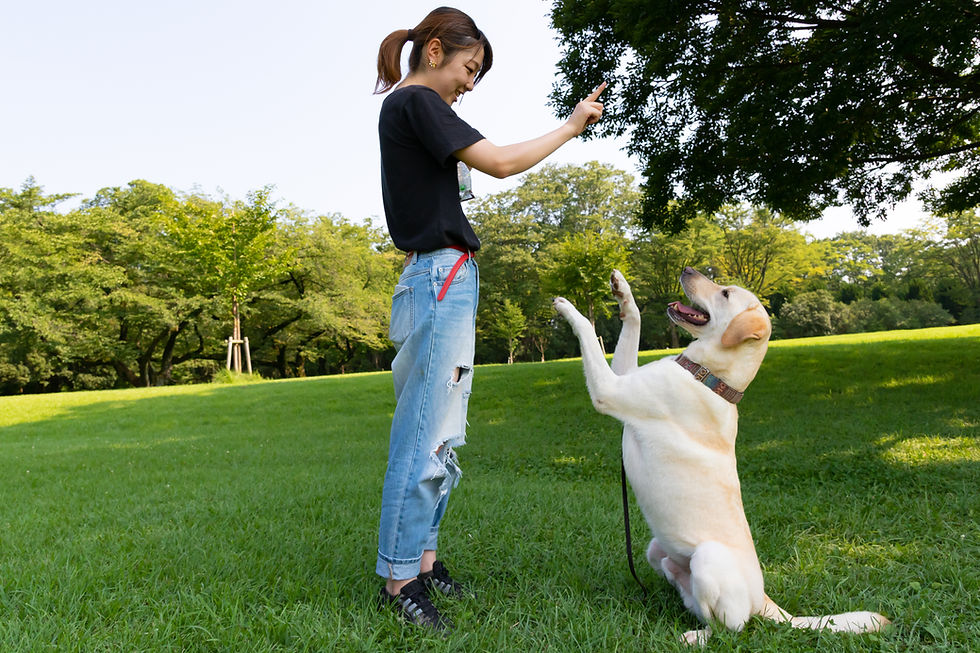How Patience and Compassion Transforms Life with Your Reactive Dog
- Ruth Hegarty

- May 7
- 3 min read

Living with a reactive dog can feel like an emotional rollercoaster. One moment you’re enjoying a peaceful walk, and the next your dog is barking and lunging at a passing bicycle, jogger, or another dog. It’s completely normal to feel frustrated, especially when you’re doing everything “right” and still running into unpleasant emotions—both yours and your dog’s. Life is stressful enough without walking your dog adding to that.
I thought of this today after getting really upset about something totally unrelated to dogs or training. I was disputing a pretty large bill and getting nowhere. I absolutely hate confrontation, and was so worked up over the situation I was physically shaking.
Right in the middle of all that, I had to take a break to walk a friend’s dog who’s staying with me this week. And I noticed—I was cranky. I found myself getting impatient with her for stopping to sniff for too long, even though she wasn’t doing anything wrong.

That’s when I caught myself.
I paused and reminded myself that this sweet, curious dog wasn’t the problem. The billing issue would resolve itself one way or another, but I was letting my frustration spill over and create negative energy between me and this pup—and she didn’t deserve that.
So I did what I always encourage my clients to do. I took a breath, had compassion for myself as a human being having a rough moment, and reframed the situation. I decided to let the billing issue go for now, apologized to the pup, and continued our walk—this time letting her sniff to her snoot’s content.
And here’s the thing: it helped. Not only was I doing better by the dog I was walking, I felt better. The stress lifted. I felt calmer, more present, and even hopeful about the resolution of my bill problem.

This is exactly the kind of shift that makes a world of difference when you're raising a reactive dog. Because one of the most powerful tools in your training toolbox isn’t a special harness or the world’s smelliest treat—it’s you. Your patience. Your compassion. Your ability to respond instead of react.
Why Patience Matters for Reactive Dogs
Reactive dogs aren’t giving you a hard time when they bark and lunge at other dogs, they’re having a hard time dealing with their emotions. Reactivity is rooted in fear, anxiety, over-arousal or past trauma. Learning is much harder when your dog is emotionally overwhelmed. When we rush, repeat cues too quickly, or let our own frustration take over, we accidentally make it even harder for our dogs to succeed.
Your ability to pause and be patient allows your dog the space to process, respond, and regulate themselves. It also gives you the chance to respond deliberately to the situation rather than react on impulse.

Compassion Starts With You
Compassion in dog training isn’t just about your dog—it’s about you, too. Living with a reactive dog can be isolating and emotionally draining. You might feel embarrassed by their behavior, or defeated by how long progress is taking. Maybe their aggressive outbursts are even frightening to you.
Give yourself compassion. You’re learning alongside your dog. You don’t need to be perfect; you just need to be present, consistent, and kind—to both of you.
What Patience Looks Like in Action
Let’s say you ask your dog to “touch” when a neighbor’s dog is approaching. If they hesitate or don’t perform the task immediately, instead of repeating the cue over and over or assuming they’re being “stubborn,” pause.
Ask yourself:
Is this a new or distracting environment?🌳
Is my dog already over threshold?🐕
Have I practiced this cue in situations like this before?🧍
Did I give clear communication and enough time?🗨️
Sometimes, what looks like disobedience is actually confusion, discomfort, or overstimulation. Take a breath. Reconnect. Try again later if needed. Progress with reactive dogs isn’t linear—but patience keeps the learning door open.
Teach the Dog in Front of You
Training a reactive dog isn’t a one-and-done event. Just like kids go through stages of development, your dog’s needs will evolve. What challenges them today might not challenge them in six months—and vice versa.
Your job isn’t to “fix” your dog. It’s to support their growth, build their confidence, and strengthen your bond along the way. That starts with meeting them where they are.

You're Not Alone!
If you’re raising a reactive dog, I see you. It’s not easy—but it is absolutely worth it. Patience and compassion aren’t just feel-good ideas—they’re evidence-based tools that help reactive dogs succeed. When you approach training with these values front and center, you’ll build trust, resilience, and the kind of connection that changes everything.
Need Help Strengthening Your Patience Muscle?
Check out my free course, Peaceful Walks Start Here: A Free Course for Reactive and Fearful Dogs







Comments